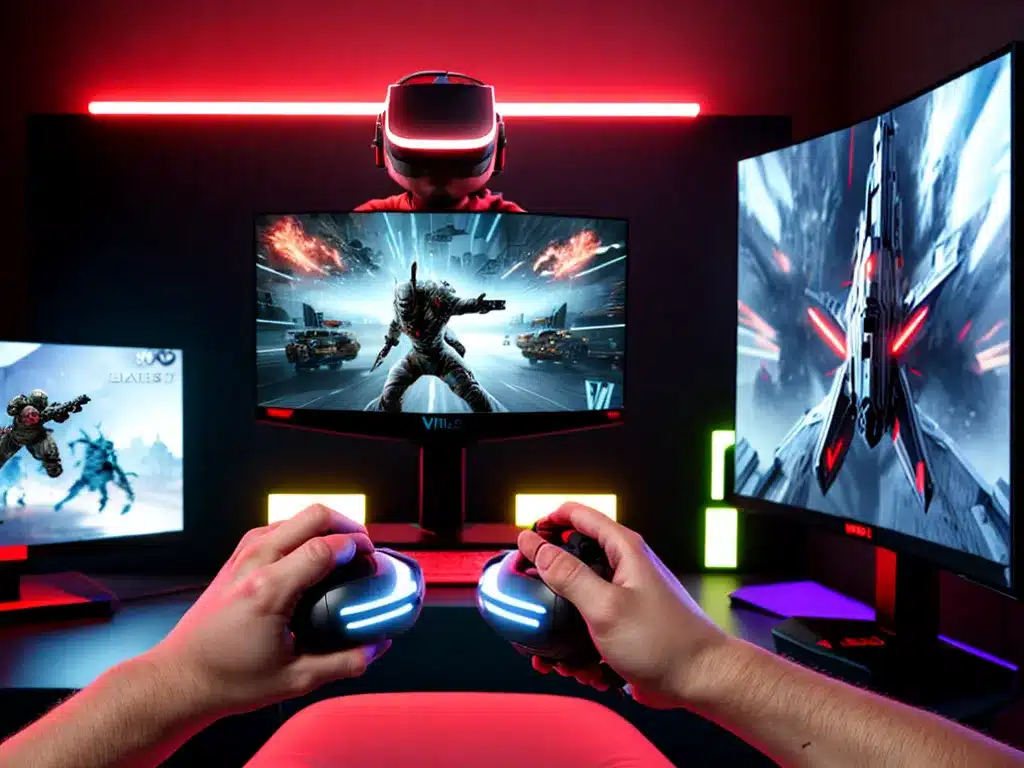
Could VR Gaming Replace Monitor Gaming in the Next 5 Years?
Virtual reality (VR) gaming has made significant strides in recent years, leading many to wonder if it could replace traditional monitor gaming in the near future. In this article, I will examine the key factors that will determine whether VR gaming can become the dominant platform within the next 5 years.
The Advantages of VR Gaming
VR gaming provides an immersive experience that just isn’t possible with traditional monitors. By blocking out the real world and surrounding the player with 3D visuals and directional audio, VR can transport gamers directly into the game world. This leads to a greater sense of presence and potentially more engaging gameplay.
Some of the key advantages of VR gaming include:
-
Greater immersion – With a VR headset filling your field of view and shutting out the real world, it’s easier to get lost in the VR experience. This immersion can make gameplay more exciting and terrifying.
-
More natural gameplay – VR allows for realistic 1:1 movement by tracking the position of your head and hands. This enables natural gameplay interactions like aiming, punching, driving etc. Monitor gaming relies on pressing buttons on a controller which is less intuitive.
-
Unique gameplay opportunities – The immersive environment enables new types of games and experiences that wouldn’t work on a monitor, like climbing Mount Everest or exploring alien planets. VR gaming is still in its infancy and developers are continuing to innovate.
-
Social experiences – Some VR platforms enable sharing a virtual space with other players, allowing for collaborative and social gameplay. This can create a greater sense of human connection.
Challenges Facing Widespread VR Adoption
While VR gaming provides benefits over monitors, there are still significant barriers to it replacing traditional gaming platforms within a 5 year timeframe. Some key challenges include:
-
High costs – Quality VR systems like the Valve Index or HTC Vive Pro 2 cost over $1000. The Oculus Quest 2 is only $299 but provides an inferior experience. The price needs to drop substantially for most gamers to adopt VR.
-
Lack of AAA games – There are currently no VR equivalents to hit franchises like Call of Duty, Grand Theft Auto, or Elden Ring. More big studios need to invest in AAA VR development.
-
Motion sickness – Fast motion in VR can cause nausea for those unaccustomed to it. New technologies need to combat this issue for VR to go fully mainstream.
-
Clunky hardware – VR headsets must become smaller and lighter before most people will use them regularly. Future advancements like augmented reality glasses could solve these issues.
-
Limited room scale – Room scale VR that allows free movement requires empty space, something not all gamers have access to. Better locomotion solutions suitable for limited spaces are needed.
The Outlook for VR Gaming in 5 Years
While the challenges are real, VR gaming has a lot of momentum and optimism surrounding it. If things go well, I believe VR gaming could potentially become the dominant platform in some gaming niches within 5 years. Here are some realistic possibilities:
-
VR becomes the standard way to experience horror games or certain first-person shooters, surpassing monitors for those genres. The extra immersion lends perfectly to heightened fear, action, and realism.
-
Casual VR gaming catches on thanks to cheaper and more accessible all-in-one wireless headsets like the rumored Apple VR headset. VR becomes the new way to play simple, fun games in short bursts.
-
VR esports start to take off as certain competitive games are developed exclusively for VR from the ground up. VRML (VR Master League) keeps growing as an esports league.
-
Hardcore gamers still prefer monitors and TVs for third-person, top-down, strategy and many big-budget games. VR becomes complementary rather than replacing monitors outright.
-
Hybrid AR/VR glasses like the rumored Apple Glass gain traction by blending virtual objects into the real world. This helps with motion sickness and enables new mixed reality gameplay concepts.
The Bottom Line
While it’s unlikely that VR gaming completely takes over within 5 years, significant progress could be made to establish VR as a popular alternative platform, especially for certain genres. As costs come down and content libraries expand, VR has the potential to transform gaming in exciting new ways. But traditional monitors will likely remain the first choice for many gamers and games in the short term. The future probably points to a hybrid model where VR gaming complements rather than replaces monitor gaming outright.












